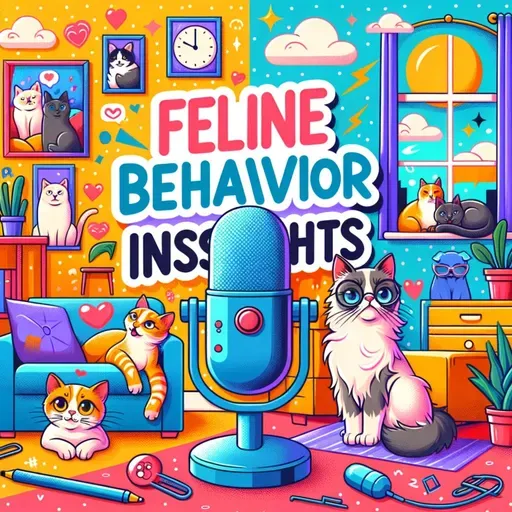
29 September 2025
Decoding Feline Behavior: Kneading, Head Bunting, and the Mysterious Language of Cats
Feline Behavior Insights
About
Feline behavior is a captivating blend of instinct, communication, and individual personality. Listeners might notice cats kneading soft surfaces, rhythmically pressing their paws in and out—this motion harks back to kittenhood. According to MedVet, kneading signals contentment and connection, as it’s similar to how kittens stimulated milk from their mothers. Additionally, cats have scent glands in their paws and use kneading to mark their territory in a comforting way.
Head bunting and rubbing are another unmistakable sign of affection in cats. When a cat rubs its head or cheeks against a person or household object, it’s both a display of love and a way to deposit its scent, claiming you as part of its territory. Best Friends Animal Society explains that these gestures, along with circling figure eights and tail flicks, paint a picture of warmth and friendship.
A cat’s body language serves as a complex communication toolkit. PetMD reports that relaxed cats stretch their limbs and tails away from their body, and a slow blink from your cat is a subtle way of saying, I trust you. When ears are upright and their tail stands high with a slight curve at the tip, a cat is happy and confident. Conversely, when a cat feels tense or threatened, ears flatten, pupils widen, and tails puff up or tuck close to the body—clear signals to give them space.
Curiosity shapes much of cat behavior. According to the Wikipedia page on cat behavior, cats are territorial but also keen observers driven by play. That urge to knock objects off a table fulfills hunting instincts and provides mental and physical stimulation, as noted by MedVet. What looks mischievous to us is, to a cat, an exercise in tracking, pouncing, and exploring their environment. Pets Best highlights that a cat might also paw around their food dish or litter box, mimicking natural burying behavior.
Bringing small gifts like a caught bug or mouse might surprise their humans, but as MedVet points out, this is how cats show appreciation. These gifts reflect their maternal instincts to provide for their family—even if their family is human.
Communication in cats extends far beyond meowing. Wikipedia’s entry on cat communication describes a wide range of visual cues—arched backs, puffed fur, and twitching tails all send important signals to other creatures. Even loafing, where a cat curls its paws under to resemble a loaf of bread, is more than adorable: it signals contentment and helps them conserve warmth, as explained by Pets Best.
Understanding feline behavior means tuning in to body language, vocalizations, and their wild mix of playfulness and affection. Every purr, blink, and tail flick has meaning, and with patience, listeners can better connect with the mysterious, engaging world of cats.
Thanks for tuning in, and don’t forget to subscribe. This has been a quiet please production, for more check out quiet please dot ai.
For more http://www.quietplease.ai
Get the best deals https://amzn.to/3ODvOta
This content was created in partnership and with the help of Artificial Intelligence AI
Head bunting and rubbing are another unmistakable sign of affection in cats. When a cat rubs its head or cheeks against a person or household object, it’s both a display of love and a way to deposit its scent, claiming you as part of its territory. Best Friends Animal Society explains that these gestures, along with circling figure eights and tail flicks, paint a picture of warmth and friendship.
A cat’s body language serves as a complex communication toolkit. PetMD reports that relaxed cats stretch their limbs and tails away from their body, and a slow blink from your cat is a subtle way of saying, I trust you. When ears are upright and their tail stands high with a slight curve at the tip, a cat is happy and confident. Conversely, when a cat feels tense or threatened, ears flatten, pupils widen, and tails puff up or tuck close to the body—clear signals to give them space.
Curiosity shapes much of cat behavior. According to the Wikipedia page on cat behavior, cats are territorial but also keen observers driven by play. That urge to knock objects off a table fulfills hunting instincts and provides mental and physical stimulation, as noted by MedVet. What looks mischievous to us is, to a cat, an exercise in tracking, pouncing, and exploring their environment. Pets Best highlights that a cat might also paw around their food dish or litter box, mimicking natural burying behavior.
Bringing small gifts like a caught bug or mouse might surprise their humans, but as MedVet points out, this is how cats show appreciation. These gifts reflect their maternal instincts to provide for their family—even if their family is human.
Communication in cats extends far beyond meowing. Wikipedia’s entry on cat communication describes a wide range of visual cues—arched backs, puffed fur, and twitching tails all send important signals to other creatures. Even loafing, where a cat curls its paws under to resemble a loaf of bread, is more than adorable: it signals contentment and helps them conserve warmth, as explained by Pets Best.
Understanding feline behavior means tuning in to body language, vocalizations, and their wild mix of playfulness and affection. Every purr, blink, and tail flick has meaning, and with patience, listeners can better connect with the mysterious, engaging world of cats.
Thanks for tuning in, and don’t forget to subscribe. This has been a quiet please production, for more check out quiet please dot ai.
For more http://www.quietplease.ai
Get the best deals https://amzn.to/3ODvOta
This content was created in partnership and with the help of Artificial Intelligence AI